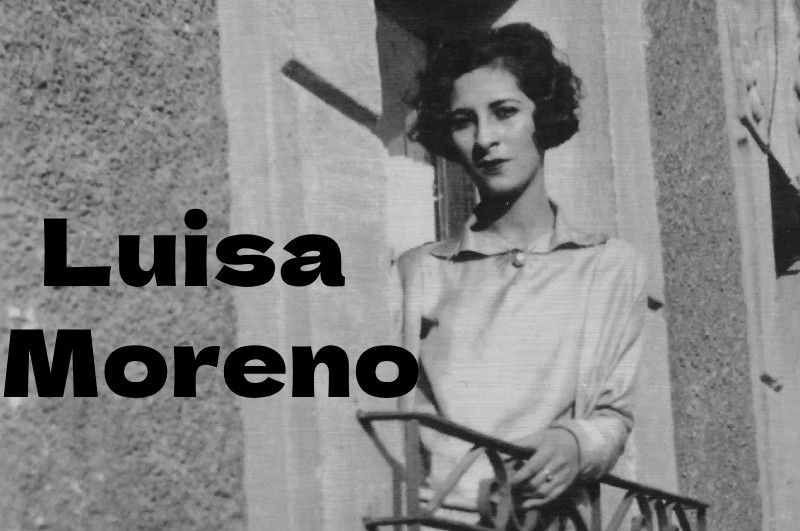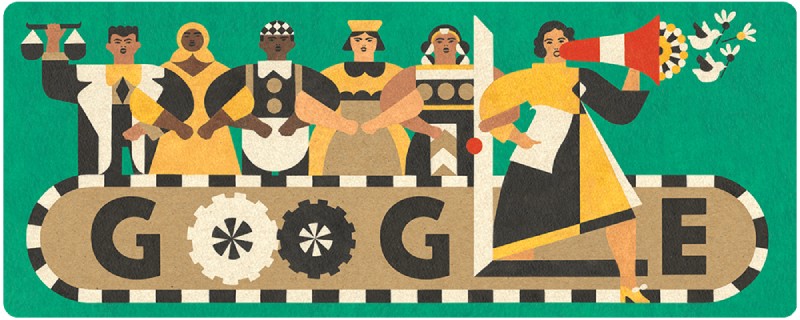Festivals & Events
Interesting and Amazing Facts about Luisa Moreno, a Guatemalan American Labor Organizer, Journalist, and Activist

Today’s Google Doodle recognizes Guatemalan American labor organizer, journalist, and activist Luisa Moreno on September 15, 2023, in honor of US Hispanic Heritage Month. Juliet Menendez, a guest artist from Guatemala City, created the Google Doodle artwork of Moreno linking arms with members of the numerous communities she tirelessly advocated. Here are some interesting and amazing facts about Luisa Moreno you should need to know.

Who was Luisa Moreno?
Here is a look at the life and work of Luisa Moreno.
Quick Look
- Birth name: Blanca Rosa López Rodríguez
- Birth date: August 30, 1907
- Birthplace: Guatemala City, Guatemala
- Died on: November 4, 1992 (aged 85)
- Death place: Guatemala
- Nationality: Guatemalan
- Alma mater: College of the Holy Names
- Famous as: A leader in the United States labor movement and a social activist
35 Interesting Facts about Luisa Moreno
- A leader in the United States labor movement and a social activist, Luisa Moreno. Before moving back to Guatemala in 1950, she organized labor unions, led strikes, wrote pamphlets in both English and Spanish and called the 1939 Congreso de Pueblos de Habla Española, the “first national Latino civil rights assembly”.
- Blanca Rosa López Rodríguez, who would later become Luisa Moreno, was born on August 30, 1907, into a prosperous family in Guatemala City.
- She organized her privileged, affluent classmates into La Sociedad Gabriela Mistral after becoming disenchanted with the gender-based limitations on educational advancement. This group was effective in getting women admitted to Guatemalan universities through petition drives and unofficial lobbying.
- Luisa Moreno left her privileged life behind at the age of nineteen to pursue a journalism career in Mexico City. She wrote poetry there as well. In 1927, she married the artist Angel De León, and the two of them went to New York City the following year. Mytyl, her daughter, was born there.
- A group of Latinos led by Gonzalo González protested the Warner Bros. film Under a Texas Moon (1930) in New York as being anti-Mexican. González was killed by police brutality during a picket. Following the murder, Moreno took part in a Pan-Latino protest.
- Luisa Moreno had attended the Oakland, California campus of the College of the Holy Names, a catholic women’s university.
- When the Great Depression hit in 1929, Moreno had to work as a seamstress in Spanish Harlem to provide for her daughter and her unemployed husband. She established a union for garment workers among her coworkers, the majority of whom were Latinas.
- The American Federation of Labor (AFL) hired Luisa Moreno in 1935 to work as a professional organizer. She moved to Florida with her daughter after leaving her physically abusive husband, where she organized unions for Latina and African-American cigar rollers.
- Luisa Moreno enlisted in the Congress of Industrial Organizations (CIO), where she represented the United Cannery, Agricultural, Packing and Allied Workers of America (UCAPAWA). In 1940, she was appointed editor of the organization’s Spanish-language newspaper.
- She assisted in organizing employees at pecan shelling plants in San Antonio, Texas, and cannery workers in Los Angeles as a representative of UCAPAWA. She urged workers from various plants to form relationships there.
- Luisa Moreno’s style of leadership emboldened other employees, especially women, and she fervently urged them to assume positions of leadership in union organizations.
- She moved to the Encanto neighborhood of San Diego in 1937, where she used it as a basis for her nationwide activism.
- Along with Josefina Fierro de Bright and Eduardo Quevedo, she was a key organizer of the Spanish-speaking People’s Congress, or El Congreso de Pueblos de Habla Española, in 1939.
- Luisa Moreno took a year off from UCAPAWA to travel across the country, visiting Latino workers on the East Coast and in the Southwest, and bringing Spanish Civil War refugees on board to support her cause.
- Her appearance before the American Committee for the Protection of the Foreign Born (ACPFB) was requested in 1940. She eloquently portrayed the life of migrant Mexican workers in her speech, which came to be known as the “Caravan of Sorrow” speech. Its legacy lasted far longer than the speech itself because portions of it were republished in Committee pamphlets.
- Luisa Moreno and her friend Robert Galván co-founded an employment agency in San Diego that same year. Additionally, she rallied the cannery workers in the San Diego area and convinced employers not to recruit scabs.
- With the start of World War II, the defense sector expanded to become a significant employer in the US, especially in San Diego. However, Mexicans were restricted from working in shipbuilding, oil, and other war-related fields and were only allowed to hold the lowest-paying jobs.
- The Sleepy Lagoon murder trial, which was a hot topic for the American left and Mexican-American civil rights activists, involved Moreno in 1942.
- Luisa Moreno established the Sleepy Lagoon Defense Committee to defend the accused children with the help of old friend Bert Corona and lawyer Carey McWilliams. The Committee also sought to dispel allegations about the “violent gangs” of Pachucos and refute sensationalist reports of urban “guerrilla warfare” between Pachucos and the military in addition to establishing a legal defense. (The attacks on Pachucos in 1943 were known as the “Zoot Suit Riots” in the media.) She also looked into the mistreatment of service members in San Diego, giving Charles C. Dail advice on the subject. She invited the Eleventh Naval District commandant in San Diego, Admiral David W. Bagley, to a meeting of local community and labor leaders. Bagley declined to accept the invitation.
- Luisa Moreno and McWilliams worked together to gather information while he persisted in calling for a probe. Jack B. Tenney, a state senator from California, was furious about the probe and publicly accused Moreno of being involved in an “anti-American conspiracy.”
- She continued to participate in the labor movement while running for Zoot Suit. She advocated for walnut pickers in El Monte with the help of the California Walnut Growers Association.
- Luisa Moreno married Nebraska-born Navy veteran and 1932 Socialist Party of America national conference delegate Gray Bemis in 1947. Bemis documented many of Moreno’s activities and shared her interest in the civil rights of Mexican Americans.
- Luisa Moreno founded the Mexican Civil Rights Committee’s San Diego chapter in the latter part of the 1940s. She warned that racial tensions and communist paranoia will lead to racial profiling, stereotyping, and police violence against Mexican Americans and other ethnic minorities in addresses to Young Progressives of America chapters.
- On November 30, 1950, Luisa Moreno and her second husband, Nebraskan Gary Bemis, departed the country and traveled to Mexico City through Ciudad Juárez. Because she had once been a member of the Communist Party, a warrant for her deportation had been issued.
- The couple eventually relocated to Guatemala, but were forced to leave when the country’s progressive President Jacobo Arbenz Guzmán was overthrown in a coup organized by the CIA in 1954.
- After the Cuban Revolution of 1959 was successful, Luisa Moreno spent some time there teaching. Before she died, she later went back to Guatemala and was interviewed by numerous historians there.
- Despite playing a significant part in both the American labor movement and the pre-Chicano Movement, Luisa Moreno’s contributions are frequently overlooked.
- Activists and historians have been trying to piece together Luisa Moreno’s role in the movements since the 1970s and give her the credit she deserves.
- One of them is the professor and muralist Judy Baca, whose Great Wall of Los Angeles honors the union of Cal San employees. The wall, a visual representation of Los Angeles’ history, honors Moreno by featuring a picture of her face surrounded by strikers.
- The “American Enterprise” exhibit at the National Museum of American History includes Luisa Moreno’s story.
- Despite Moreno’s tireless efforts to better the lives of thousands of US workers, the Immigration and Naturalization Services (INS) targeted her because of her position as a labor leader.
- Luisa Moreno started receiving deportation threats from the INS unless she testified against other union leaders.
- She was compelled to leave the US and go back to Latin America because she refused to comply.
- Luisa Moreno continued her efforts thereby organizing workers in Guatemala, Cuba, and Mexico.
- On September 15, 2023, Google featured a Google Doodle on its homepage to celebrate Luisa Moreno in honor of US Hispanic Heritage Month.
-

 Sports4 weeks ago
Sports4 weeks agoFIFA Club World Cup 2025: Complete List of Qualified Teams and Groups
-

 Sports2 weeks ago
Sports2 weeks agoAl Ahly vs Inter Miami, 2025 FIFA Club World Cup – Preview, Prediction, Predicted Lineups and How to Watch
-
Health1 week ago
Back to Roots: Ayurveda Offers Natural Cure for Common Hair Woes
-
World4 weeks ago
Omar Benjelloun: Strategic Architect Behind Major Financial Deals in the MENA Region
-

 Sports3 weeks ago
Sports3 weeks agoFIVB Men’s Volleyball Nations League 2025: Full Schedule, Fixtures, Format, Teams, Pools and How to Watch
-

 Tech1 week ago
Tech1 week agoFrom Soil to Silicon: The Rise of Agriculture AI and Drone Innovations in 2025
-

 Startup2 weeks ago
Startup2 weeks agoHow Instagram Is Driving Global Social Media Marketing Trends
-

 Science4 weeks ago
Science4 weeks agoEverything You Need to Know about Skywatching in June 2025: Full Moon, New Moon, Arietid Meteors, and Planetary Marvels























